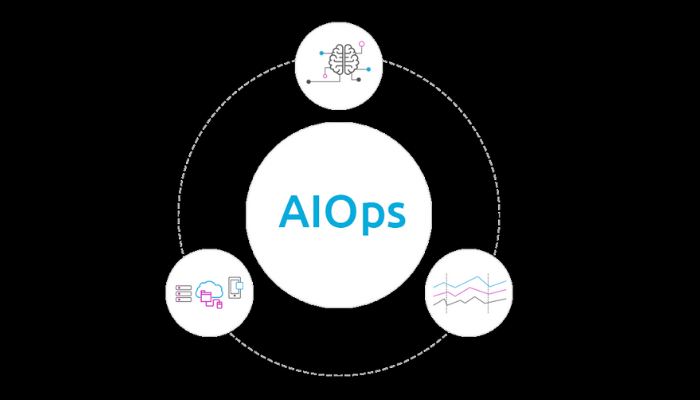What is AIOps?
AIOps is an abbreviation for Artificial Intelligence for IT Operations. AIOps utilizes big data, machine learning, and automation technologies to support activities, including service desks, automation processes, and data centre monitoring.
AIOps platform merges Big Data, and Machine Learning (ML) functions to enhance and partially replace primary IT operations like performance monitoring, IT service management, automation, and event correlation and analysis. It automatically addresses issues in real-time while providing traditional analysis.
AIOps brings together the three different IT disciplines:
- Service Management (Engage)
- Performance Management (Observe)
- Automation (Act)
Gartner predicts that the exclusive use of AIOps in large enterprises will save operational expenses by 30% by 2024.
Some of the major Elements of AIOps are:
- Big Data: This includes modern big data platforms like Elastic Stack, Hadoop 2.0, or Apache technologies. They allow real-time processing.
- Artificial Intelligence (AI): AI is trained to adapt to the unfamiliarity in an environment.
- Machine Learning (ML): ML automates pre-existing, manual analytics and authorizes new or altered analytics. It is based on the output of new data. The scale and speed are thanks to AIOps.
AIOps Tools:
Since AIOps can be integrated with different information sources, the area of AIOps tools vendors is extensive. These tools are of two types, and it depends on how they collect information. These are:
- Domain Agnostic: Tools that rely heavily on integrations with different services to collect data.
- Domain Centric: Tools that collect most or all required information themselves. Domain-centric tools are inclined towards special domains: log management and Application Performance Monitoring (APM).
Domain Agnostic Tools
1. BigPanda
BigPanda collects data from distinct services to feed its ML algorithms with correlation and problem identification. BigPanda offers a free version and a free trial. It includes features such as dashboard, assignment management, escalation management, issue auditing, knowledge-based project management, and so on.
2. Splunk/Victorops
Splunk and Victorops can be used either independently or together. Splunk falls under the Domain Centric World as it is designed for large amounts of log data. However, in unification with Victorops, it’s only one of the many integrations to source data from.
Splunk makes it easier to collect, analyze the data, and take action upon the unused value of big data. Victorops provides an analytical engine to correlate the gathered data from multiple services.
3. Moogsoft
Moogsoft integrates with external services to collect the necessary information. It provides noise reduction, detects incidents prior, and fixes problems with speed and efficiency.
Domain Centric Tools
1. AppDynamics
AppDynamics is is a software company founded in 2008 in the USA. It offers software known as “AppDynamics” that provides its data collectors. The data retrieved from external systems are integrated into correlation algorithms. It includes features such as diagnostic tools, performance control, and resource management.
2. New Relic
Its AI capability supports features devoted to AIOps. The New Relic One platform collects information through self-deployed agents. It stores correlate and create cases. New Relic’s integrations with external tools are vast.
3. Zenoss
This software complements SaaS, Mac, Windows, iPhone, and iPad. For AIOps, it is combined with log and incident management, intelligence and automation. “ZenPacks” can integrate into all kinds of systems. Data is collected through these ZenPacks. The app offers a free version and 24/7 live support.
Benefits of AIOps

- Fast Data Processing: AIOps can enable real-time data correlation. Raw data can be consumed by smart algorithms generated by big data and ML. It helps in the creation of new targets for key metrics.
- Data-driven Decision Making: AIOps brings ML techniques that can learn from data without rule-based programming to ITOps. This helps in decision making by enabling data-driven automated responses. Such responses eliminate human error.
- Proactiveness in IT work: in a business environment, the success of any business depends on customer satisfaction. Hence, it is essential to predict possible issues and delays. AIOps aids ITOps to predict and provide solutions for performance issues across all applications, services, and infrastructure.
- Improved Root Cause Analysis: Machine Learning and analytics enable the systems to execute root cause analysis. This increases its ability to troubleshoot and rectify unusual issues, resulting in improved data analytics.
- Reduced burden on staff: AIOps reduces time and improves problem identification. The increased automation tends to minimize time given by staff on mundane, routine tasks every day. They can focus on complex issues and initiate processes that increase business stability and performance.
Conclusion
As the volume of data increases across all the digital platforms, it becomes challenging to manage it manually. While automation has helped in operational planning, today’s complex environment demands more.
By applying AI to ITOps, problems can be easier to predict and prevent. It accelerates diagnosis and analysis, minimizing disruption to customers.
Hence, the long-term impact of AIOps on performance monitoring and IT as a whole will be transformative. Therefore, companies must make a wise choice before the implementation of AIOps.
Also Read:
